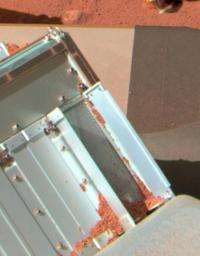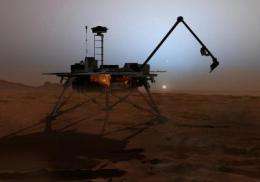Phoenix Mars Lander finds surprises about red planet's watery past

(PhysOrg.com) -- Liquid water has interacted with the Martian surface throughout Mars' history, measurements by NASA's Phoenix Mars Lander suggest.
The findings, published in the Sept. 10 issue of the journal Science, also suggest that liquid water has primarily existed at temperatures near freezing, implying hydrothermal systems similar to Yellowstone's hot springs on Earth have been rare on Mars throughout its history.
These surprising results come from measurements Phoenix made in 2008 of stable isotopes of carbon and oxygen in the carbon dioxide of the Martian atmosphere. Isotopes are variants of the same element with a different number of neutrons, such as carbon-12, with six neutrons, and the rarer carbon-13, with seven.
Unprecedented precision in determining the ratios of isotopes in Martian carbon dioxide sheds new light on the history of water and volcanic activity on the surface of Mars.
The measurements were performed by the Evolved Gas Analyzer on Phoenix, part of the lander's Thermal and Evolved Gas Analyzer, or TEGA, an instrument designed and built at the University of Arizona. TEGA's mass spectrometer was capable of a more accurate analysis of carbon dioxide than the ones on NASA's Viking landers in the 1970s, the only other such instruments that have returned results on isotopic composition from Mars.
"We use the TEGA instrument as a crime scene investigator," said William V. Boynton, a professor at the Lunar and Planetary Lab in the UA's department of planetary sciences. "Like a chemical fingerprint, isotopes tell us what process is responsible for making the material we are studying." Boynton, who heads the group that built the TEGA instrument, co-authored the Science paper.
Carbon dioxide makes up about 95 percent of the Martian atmosphere. NASA's Mars Exploration Program has put a high priority on learning more about the isotope ratios in Martian carbon dioxide to supplement the information from Viking and from analysis of meteorites that have reached Earth from Mars.
For the measurement, the TEGA instrument on the lander opened a pin-point-sized hole while a vacuum sucked a puff of Martian atmosphere into its chamber for isotope analysis.

The analysis revealed that carbon dioxide on Mars has proportions of carbon and oxygen isotopes similar to carbon dioxide in Earth's atmosphere. This unexpected result reveals that Mars is a much more geologically active planet than previously thought. In fact, the new results suggest that Mars has replenished its atmospheric carbon dioxide relatively recently, and that the carbon dioxide has reacted with liquid water present on the surface.
"Atmospheric carbon dioxide is like a chemical spy," said Paul Niles, a space scientist at NASA's Johnson Space Center in Houston and lead author of the paper. "It infiltrates every part of the surface of Mars and can indicate the presence of water and its history."
The low gravity and lack of a magnetic field on Mars mean that as carbon dioxide resides in the atmosphere it will be lost to space, a process that favors loss of the lighter carbon-12 isotope compared to carbon-13. Although an older atmosphere on Mars should contain much more carbon-13, it doesn't. This suggests that the Martian atmosphere has been recently replenished with carbon dioxide emitted from volcanoes, and volcanism has been an active process in Mars' geologically recent past.
Another clue comes from the second element that makes up carbon dioxide: oxygen. Oxygen, like carbon, comes in different isotopes: oxygen-16 and the heavier oxygen-18.
The team compared the results from Phoenix to measurements obtained from Martian meteorites that were hurled into space from the Red Planet's surface during impact events and eventually fell onto Earth where they were later collected. The meteorites contain carbonate minerals that form only in the presence of liquid water and carbon dioxide.
"Carbon dioxide spewed into the atmosphere by volcanoes is very similar in its oxygen isotope ratio to that found in rocks," said Boynton. "But we see a big difference between the oxygen ratios of the volcanic rocks and the atmosphere."
This suggests that the carbon dioxide in the volcanic rock of Martian meteorites has reacted with liquid water, enriching the oxygen in carbon dioxide with heavier oxygen-18.
The comparisons of isotopes in Mars' atmosphere with those in the meteorites provide confirmation of key findings. For example, one meteorite that crystallized during recent geological time on Mars -- about 170 million years ago rather than billions of years ago -- has carbonates with isotopic proportions that match the atmospheric measurements by Phoenix.
According to Niles, the isotopic signature indicates that liquid water has been present on the Martian surface recently and abundantly enough to affect the composition of the current atmosphere. It also reveals the water has primarily existed at temperatures near its freezing point.
The results provide supporting evidence that the watery conditions associated with carbonate formation have continued even under Mars' current cold and dry conditions.
"This shows that the carbonates formed under the influence of water and the atmosphere in the recent geologic past," Boynton said.
Niles added: "The findings do not reveal specific locations or dates of liquid water and volcanic vents, but geologically recent occurrences of those conditions provide the best explanations for the isotope proportions we found."
Provided by University of Arizona




















